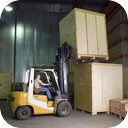(short preview of full seamless looping track)
(short preview of full seamless looping track)
(short preview of full seamless looping track)
(short preview of full seamless looping track)
(short preview of full seamless looping track)
Loading Pallets
This product is not available in the selected currency.
In Stock
Backordered
Out of Stock
Description
The great warehouse, unnaturally huge, is filled to the brim with boxes and crates of all sizes, sitting precariously upon stacks of pallets piled as high as the roof. The lone forklift driver must use every bit of skill he has to navigate the tight isles between wooden high rises, and delicately dance the tonnage into place. One wrong move and the entire industrial product of a city will come crashing down upon his head. A pallet, sometimes called a skid, is a flat transport structure that supports goods in a stable fashion while being lifted by a forklift, pallet jack, front loader or other jacking device. A pallet is the structural foundation of a unit load which allows handling and storage efficiencies. Goods or shipping containers are often placed on a pallet secured with strapping, stretch wrap or shrink wrap and shipped. Containerization for transport has spurred the use of pallets because the shipping containers have the clean, level surfaces needed for easy pallet movement. Most pallets can easily carry a load of 1,000 kg (2,205 lb). Today, over half a billion pallets are made each year and about two billion pallets are in use across the United States alone. Pallets were slowly introduced throughout the early 20th century; wooden boxes, crates, barrels and kegs were much more commonly used to unitize, protect, store and transport goods. The high lift fork truck first appeared in 1915. With further modification in 1919, the truck could lift loads several feet high while other improvements included cantilever design and forks. The emergence of forks as well during the same period enabled lift trucks to handle a much greater range of materials.
This sound uses the following file from Freesound: http://www.freesound.org/people/miastodzwiekow/sounds/127190/
Opps
Sorry, it looks like some products are not available in selected quantity.



